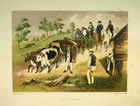On the goldfields, death was omnipresent. The hardship and danger of mining life – falls; shaft collapses; drowning; dysentery and contagious diseases (accelerated by over-crowded and unhygienic living conditions); and riding accidents – as well as occurrences from natural causes, made death commonplace. Initially, cemeteries were not a government concern and crudely dug graves appeared on slopes and gullies – or anywhere that the landscape wasn’t marked by the holes of gold diggers. Randomly and informally located within the vicinity of most neighbourhoods, cemeteries and single graves littered the diggings. Consequently, Forest Creek alone had six cemeteries by the end of 1852, and many more in its near vicinity. For some people, death’s presence was an opportunity to prosper. In 1853, an American established a funeral business in Ballarat and was known by his white flag with its emblem of a black coffin.
Depending on the location and fortunes of friends or family, people were buried in wooden coffins or boxes, wrapped in bark and placed in shallow graves, or simply covered with nearby branches. In November 1851, a correspondent for the Argus noted: ‘two children died on the creek since my last, from dysentery, and boards are so scarce, that boxes are brought to make coffins of.’ Rocks, or a palisade, sometimes encircled graves. They usually remained unmarked but sometimes the name of the deceased was marked on a wooden stack.
For most people, the unmarked grave remained as mysterious as the man buried in it. Because much of the goldfield populations were itinerant, some men died without disclosing information of loved ones, and thus news of their passing went unannounced in their native villages or towns. In recollecting a German man who died without divulging his native address, or details about his family back home, William Howitt sadly lamented:
no doubt his family ... still live in the hopes of golden tidings that will never reach them; still, sometimes, no doubt, think it unkind that they send no greetings. Those who should send them lie in the wilderness, enclosed with one of those square palisade fences which mark the diggers’ graves.
In 1852, with the stench from shallow graves becoming unbearable and health concerns escalating, people from Mount Alexander began to lobby the government for an official cemetery. Soon a public cemetery of four acres was established, near present day Templeton and Baker Streets. Four years later, the Campbells Creek Public Cemetery was formed and bodies from the older site were exhumed and relocated to the new burial ground. In 1852, the Vaughan Chinese Cemetery was established on a rocky hill; Chinese miners continued to be interred there until 1857.
Following the Eureka Stockade uprising, the dead were placed in the Old Ballarat Cemetery, on Creswick Road. In 1856, a Diggers Memorial was erected to honour the miners who had lost their lives during the rebellion. Located within an iron palisade, the monument was created by Geelong sculptor, James Leggatt, and consisted of a stone pillar with the names of the deceased etched on it. Atop the pillar stood a stone funeral urn draped in cloth.


